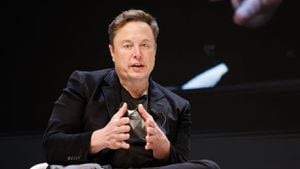The vibrant space industry witnessed a captivating moment as Europe launched its much-anticipated Ariane 6 rocket. Initiated from the Guiana Space Centre in Kourou, French Guiana, the rocket took to the skies at 3:01 p.m. Eastern Time, after a slight delay due to a data acquisition issue. The mission aimed to place a series of satellites into orbit, followed by a re-entry procedure. However, as often happens in space missions, not everything went as planned.
The excitement was palpable in the air as technicians and engineers applauded the rocket’s initial performance. Indeed, the launch was mostly smooth, with the rocket ascending gracefully and deploying several satellites into their respective orbits. However, minutes before the planned re-entry, an "anomaly" – a term often used in aerospace to denote unexpected issues – caused a premature shutdown of the upper stage engine, halting the mission's final tasks. This glitch prevented the rocket from fully completing its journey back to Earth, thus limiting the demonstration of its full capabilities.
Even with this hiccup, the mission was still deemed a triumphant success. "We're relieved; we're excited," exclaimed Josef Aschbacher, director general of the European Space Agency (ESA). "Launching a new heavy-lift rocket successfully is a historic achievement that doesn't occur every day. It happens once every two to three decades." His remarks capture the significance of the occasion, underscoring the meticulous efforts gone into the development of Ariane 6.
The journey of Ariane 6 to its maiden flight has been lengthy and fraught with challenges. Conceived to replace the retiring Ariane 5, its development started in 2014 with the goal of a launch-ready rocket by 2020. However, it wasn't until July 9, 2024, that the rocket finally soared from its launch pad. Built with a price tag of approximately €4 billion ($4.32 billion USD), the rocket embodies Europe's ambition to secure autonomous access to space.
The rocket's construction features state-of-the-art technology, integrating innovations such as 3D printing and friction stir welding. These advanced techniques enable faster and more cost-effective manufacturing processes. Available in two configurations, the "62" with two solid-fuel side boosters, and the "64" with four boosters, Ariane 6 is equipped to handle a diverse range of payloads. Its upper stage, designed with the capability to stop and restart multiple times, allows for precise satellite placements and efficient utilization.
However, Europe faces stiff competition from across the Atlantic. As Europe rolled out its Ariane 6, the commercial space launch market has experienced a seismic shift, thanks to SpaceX's innovative approach. The American company's Falcon 9 rockets, known for their reusability, have disrupted traditional models and significantly lowered launch costs. This competitive landscape forces Ariane 6 to strive not just for functional excellence but also for economic viability.
Despite these challenges, the Ariane 6 has already secured significant contracts. Among them is a multi-launch agreement to deploy Amazon’s constellation of internet-beaming satellites. Such partnerships highlight the confidence that prestigious clients place in Ariane 6’s capabilities. "We have an order book that is full," confirmed Lucia Linares, head of space transportation strategy at ESA. This statement underscores the market's faith in the new rocket, notwithstanding the anomaly during its inaugural flight.
The inaugural mission of Ariane 6 represents a broader objective for the European space strategy. Hermann Ludwig Moeller, director of the European Space Policy Institute, emphasized that Ariane 6 is vital for implementing Europe's long-term space policy. He pointed out that Europe's investment in space must double by 2040 to maintain its competitive edge. Moeller's remarks resonate with a clear message: the success of Ariane 6 is not just a technical milestone but a strategic imperative for Europe's future as a leading space power.
The end of Ariane 5's era marks a new beginning. Reflecting on its storied past, Ariane 5 dominated the commercial launch market for decades before being overshadowed by new players like SpaceX. Ariane 6 stands as a successor, built on lessons learned and designed to compete in an even more challenging environment. While full reusability is the future that Europe aims for, technologies enabling it may not be ready until the 2030s. Until then, Ariane 6 will establish its niche, continually proving the reliability and efficiency necessary to keep Europe in the global space race.
Looking ahead, Ariane 6's roadmap is ambitious, aiming for regular launches and broadening its mission portfolio. Ensuring demand from European institutional clients and winning additional commercial contracts are pivotal steps for its sustained success. As ESA continues to analyze the data from this first flight, the anticipation for subsequent missions builds up. Engineers and scientists are already preparing for the next set of launches.
"This is just the first step," highlighted Josef Aschbacher before the launch. "We have lots of work to do yet, but we are laser-focused on changing the future of the European space transportation ecosystem." This sentiment encapsulates the spirit of innovation driving Europe’s endeavors in space technology.
The maiden flight of Ariane 6 encapsulates a blend of technological achievement and strategic foresight. It reflects Europe's resolve to maintain autonomous access to space and carve out its role amidst fierce global competition. While the journey of Ariane 6 has just begun, it signals a promising future for Europe's aspirations beyond Earth. The world will be watching closely as Ariane 6 continues its odyssey, marking milestones that could shape the contours of space exploration for years to come.
The spectacle of the Ariane 6 launch, despite its minor setbacks, renews hope and excitement for future missions. It's a testament to human resilience and the relentless pursuit of progress – qualities that define our exploration of the final frontier.



